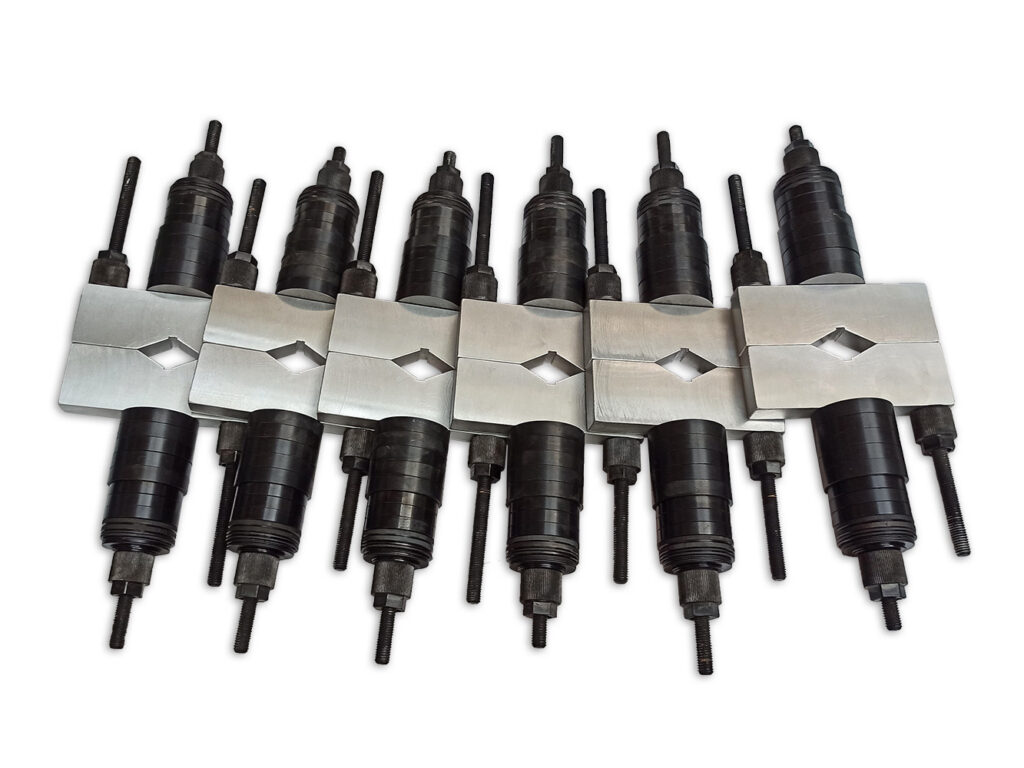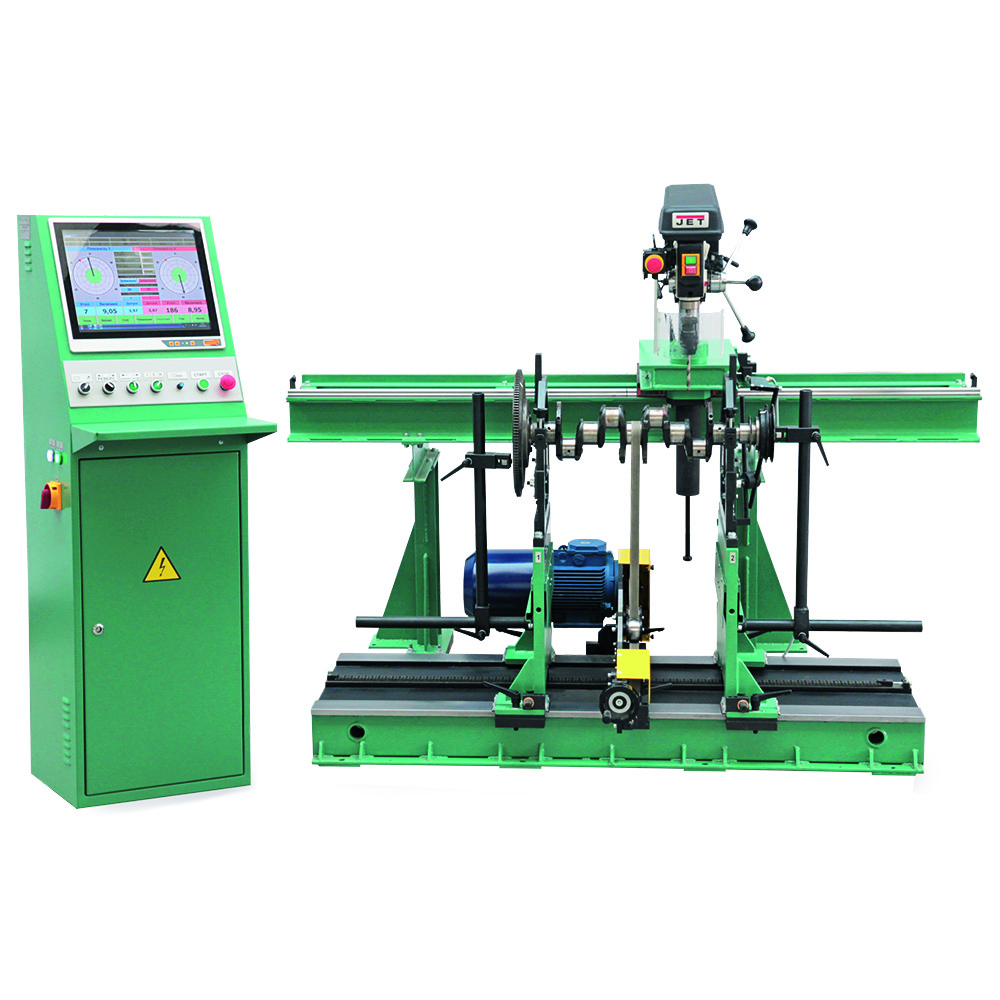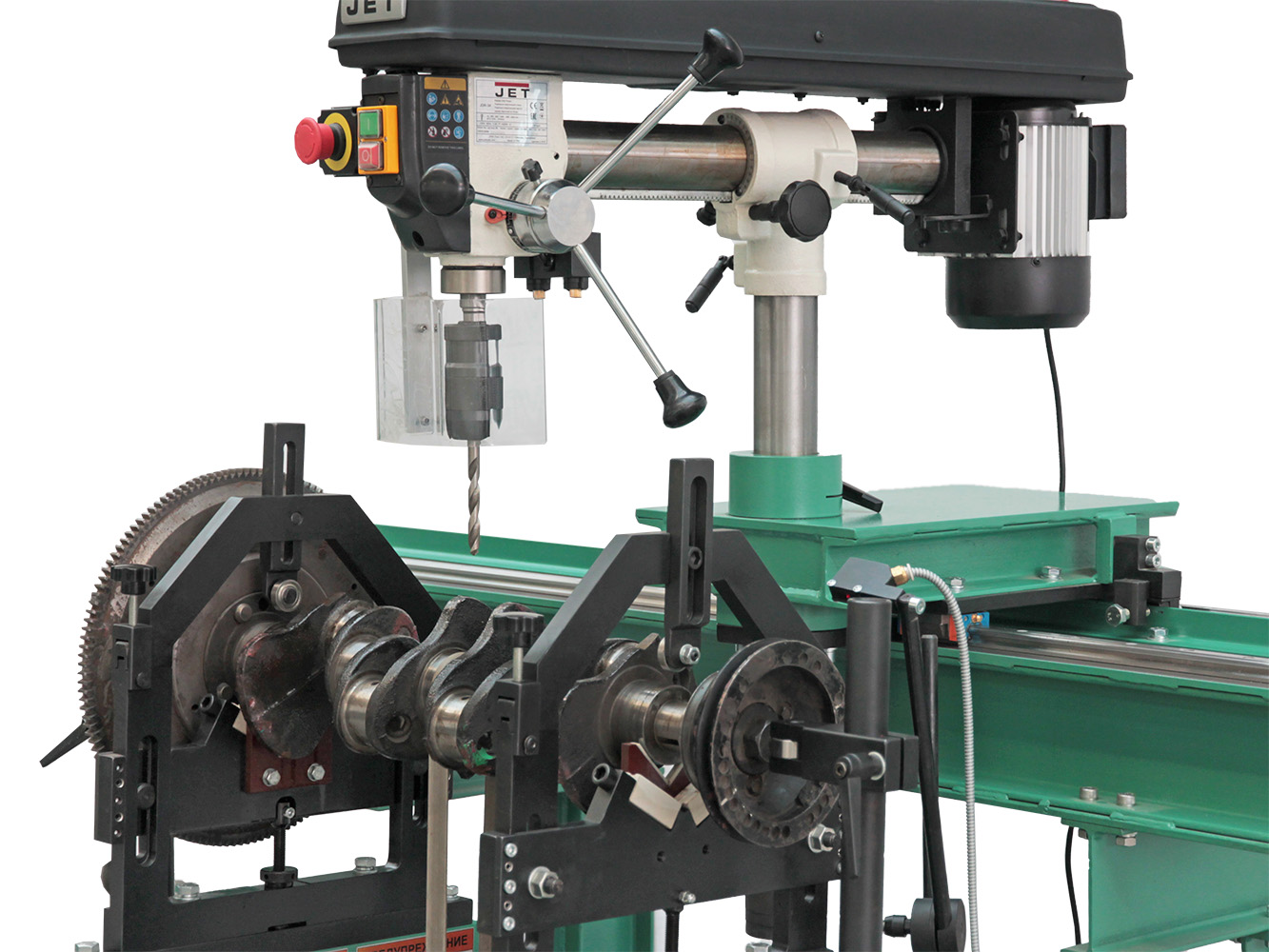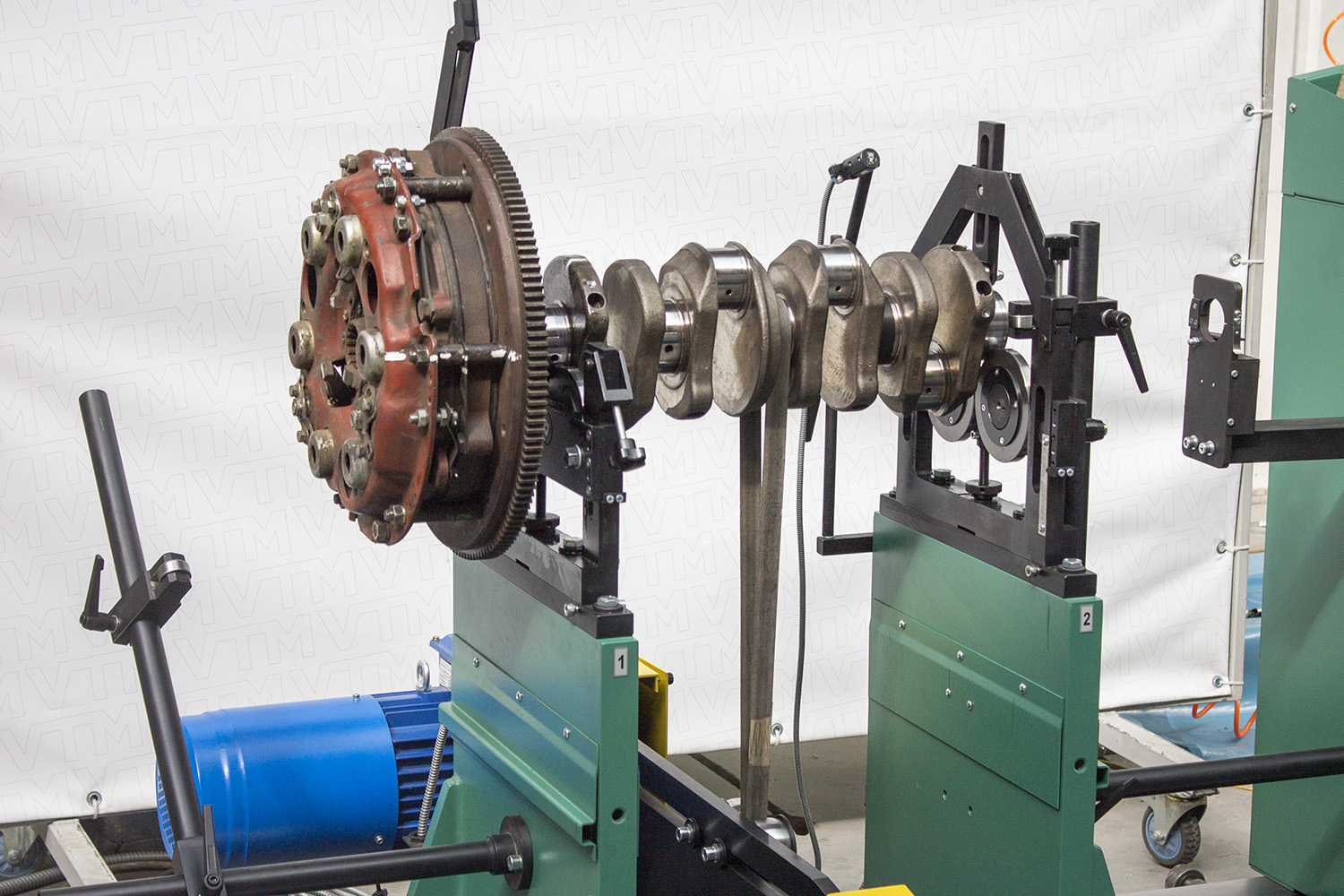Maximal weight, kg
Maximal diameter, mm
Reliable balancer for engine workshops
The 9D715US machine has unique capabilities that allow it to effectively handle a wide range of crankshaft balancing tasks in engine overhaul shops.
Thanks to its innovative technology and high performance, it solves the following tasks:
- Measuring and correcting large initial crankshaft imbalances.
- The narrow support rollers allow the crankshaft to be balanced complete with flywheel and pulley, while the compact size of the belt drive eliminates the difficulties of balancing with bobweights attached to the crankshaft.
- An integrated drilling unit mounted on its own guides increases the productivity of the balancing operation.
- The software function for converting unbalanced mass to drilling depth ensures accurate and efficient unbalance correction directly on the machine.
With the 9D715US balancing machine you get a reliable and powerful tool for high accuracy and quality crankshaft balancing.
The universal balancing machine model 9D715US can handle these types of parts :
- Inter-supported “shaft” type (the center of mass of the part is between the supports);
- Cantilever type (most of the part mass is located on one side behind the supports);
- Disc type part (if the part does not have its own bearing journals, a mandrel is used for balancing);
- A part on its own bearings.
The unbalance is detected by means of force sensors located in the vibrating supports and a velocity sensor which monitors the rotation of the part. The force transducers convert the support vibrations caused by the unbalanced part into digital signals. The rotational frequency of the part is also converted into electrical pulses. The information from the sensors is processed by the balancer’s computing unit, then output in a convenient format to an information output device such as a computer or a microprocessor screen.
- High accuracy 0,4 gmm/kg = 0,4 μm.
- Real-time balancing process.
- Short unbalance measurement time.
- Maximum machine sensitivity with operator-controlled setup and calibration.
- Replaceable sliding V-bearings allow gentle crankshaft balancing.
- Measures large initial unbalances without damaging the machine.
- Belt drive design for rotating any rotor.
- Vertical drilling unit for unbalance correction directly on the machine.
- Narrow support stands enable balancing of crankshafts with narrow journals.
- Smooth speed control and acceleration through a frequency inverter drive.
Specialized Crankshaft Engineering
- Crankshaft-specific construction– Engineered exclusively for engine overhaul shops with capability to balance various crankshaft types including complete assemblies with flywheel and pulley attachments. The machine accommodates V-type crankshafts with attached bobweights, handling the complex geometry and mass distribution unique to automotive and industrial engine applications.
- High-precision crankshaft measurement– Achieves exceptional balancing accuracy of 0.4 g·mm/kg (0.4 µm) specifically calibrated for crankshaft tolerances and engine performance requirements. This precision level ensures optimal engine smoothness and bearing life extension critical for professional engine rebuilding operations.
- Comprehensive crankshaft size range– Accommodates crankshafts weighing 3-300 kg with journal diameters from 30-180 mm and center distances of 150-1350 mm, covering passenger vehicles through heavy-duty industrial engines. The versatile sizing ensures compatibility with virtually all crankshaft configurations encountered in engine overhaul facilities.
Advanced Precision Construction
- Monolithic support and base design– Rigid one-piece construction eliminates vibration losses during balancing by minimizing oscillation system elements, crucial for accurate crankshaft measurement with inherent mass asymmetries. The monolithic approach provides superior structural integrity compared to assembled designs for consistent long-term accuracy.
- “Exact Barrel”® roller technology– Features specially designed rollers assembled with precision bearings and utilizing patented grinding technology for superior contact accuracy with crankshaft journals. This advanced roller design minimizes measurement errors caused by surface variations and ensures consistent support throughout the balancing process.
- MICRO-TUNING® axial compensation– Proprietary technology automatically eliminates effects of axial misalignment during rotation, critical for crankshafts where perfect alignment is difficult to achieve. This system maintains measurement accuracy despite the inherent setup challenges presented by crankshaft geometry and weight distribution.
Integrated Correction Capabilities
- On-machine drilling module– Integrated drilling system enables unbalance correction by material removal from counterweights without crankshaft removal from the machine. This capability significantly increases productivity by eliminating setup time while maintaining precise correction placement relative to measurement reference points.
- Adjustable roller block height– Accommodates crankshafts with varying journal diameters and enables precise centering during machine setup, essential for accurate measurement of complex crankshaft geometries. The adjustment capability ensures optimal support contact regardless of crankshaft design variations.
- Large unbalance handling capability– Designed to measure and correct large initial unbalances typical of damaged or heavily worn crankshafts without machine damage or measurement degradation. This robust capability is essential for engine overhaul applications where crankshafts may have significant existing unbalance conditions.
Optimized Drive and Control Systems
- Variable frequency belt drive– 2.2 kW motor with frequency inverter provides smooth acceleration and infinitely variable speed control from 300-1500 rpm, optimized for crankshaft balancing requirements. The power reserve reduces cycle times while maintaining precise speed regulation throughout the measurement process.
- LONG STROKE® belt design– Patented belt drive system accommodates crankshafts of varying lengths using only two drive belts, providing reliable power transmission regardless of crankshaft configuration. This design eliminates the need for multiple belt configurations while ensuring consistent drive engagement.
- Low resonance frequency operation– Support system designed with low natural resonance frequency enables accurate balancing at reduced rotational speeds, important for heavy crankshafts where high-speed operation may be impractical. This feature enhances both safety and measurement quality for large engine components.
Engine Shop Integration Features
- Compact engine shop footprint– 1600 mm base length with maximum 1300 mm rotor diameter clearance provides efficient space utilization typical of engine overhaul facilities. The compact design maximizes functionality while fitting into standard automotive service bay configurations.
- Real-time measurement display– PAK-1 balancing system with industrial PC and touch screen provides continuous monitoring of unbalance behavior during measurement, enabling immediate assessment of crankshaft condition. The real-time feedback accelerates decision-making for correction procedures.
- Modular configuration options– Supports various drive configurations including axial drive with cardan shaft for high-torque applications and combined drive systems for shops handling diverse engine types. The modular approach allows customization for specific engine overhaul requirements while maintaining standardized operation procedures.
Professional Service Optimization
- External vibration immunity– Advanced isolation system provides high protection against shop floor vibrations and measurement disturbances common in automotive service environments. This immunity ensures consistent accuracy despite the variable conditions typical of engine overhaul facilities.
- Operator-friendly calibration– Machine setup and calibration procedures designed for operator execution without specialized technical knowledge, reducing dependency on external service technicians. This self-service capability maintains productivity and reduces operational costs in busy engine overhaul operations.
The PAK-1 unbalance measuring unit represents the latest generation of measuring complexes for dynamic balancing, combining high precision, stability, and ease of use. It’s designed to tackle a wide range of rotor balancing tasks, from simple to the most complex, requiring precise measurements.
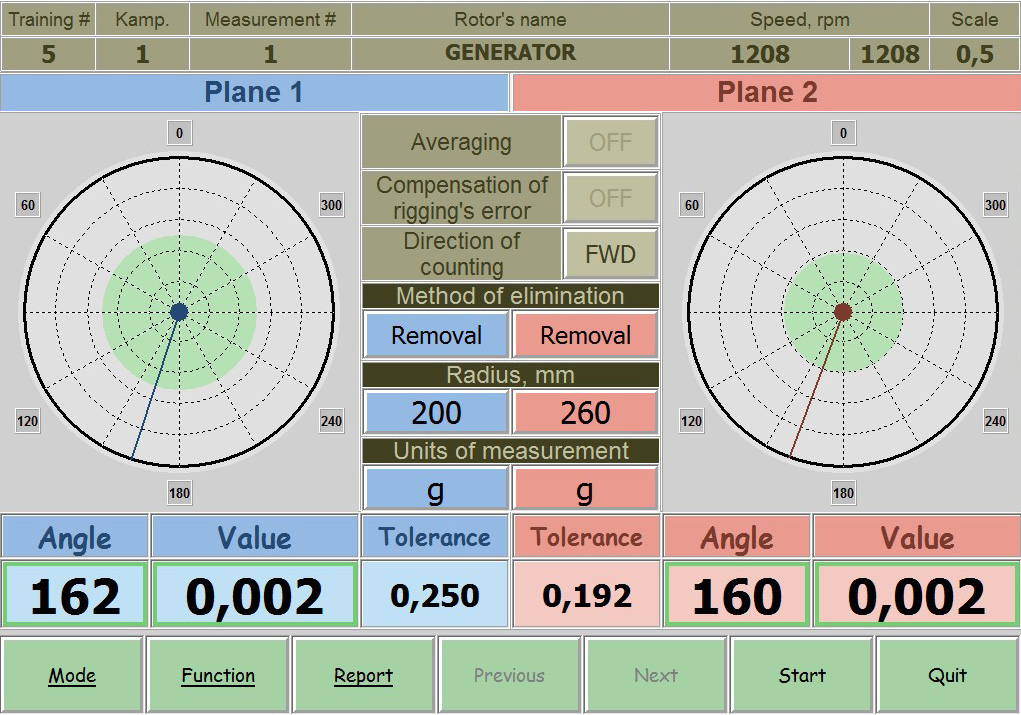
Based on an industrial fanless computer with a touchscreen and a multi-channel measuring unit, the system ensures reliability and a long service life, even under intensive use. The PAK-1 utilizes a universal measuring path and modern component base, allowing for equally high accuracy when working with all types of rotors.
Its intuitive interface, self-calibration capability, and automation of key operations make the complex a convenient tool for both experienced specialists and beginners.
Features of the PAK-1 System:
- High-precision dynamic balancing for rotors of any configuration.
- Industrial fanless PC with touchscreen and multi-channel measuring unit.
- Setup using trial runs with calibration weights on production rotors.
- Self-calibration by the operator, eliminating annual service adjustment costs.
- Calculation of permissible unbalance values, even without technical documentation.
- Determination of control weight mass to simplify setup for a specific rotor.
- Real-time display of unbalance magnitude and angular position, including “highlighting” of the correction zone.
- Automatic measurement start upon reaching a set speed and automatic stop after cycle completion.
- Display of unbalance magnitude in grams, gmm, gcm, gmm/kg.
- Vector and exponential averaging for working with moving elements and in noisy conditions.
- Additional functions that significantly simplify the balancing process and expand the technological capabilities of the balancing machine.
- Generation and printing of balancing reports directly from the system.
- USB ports and Ethernet interfaces for connecting a printer, data storage, and integration into a local network.
|
Parameter |
Value |
|---|---|
|
Balancing rotors weight range, kg |
3 – 300 |
|
Maximum rotor diameter (over the bed), mm |
1100 |
|
Distance between rotor bearing journal centers, mm, min/max |
150 – 1350 |
|
Rotor bearin journals diameter, mm |
20 – 140 |
|
Machine type |
Hard-bearing |
|
Support type |
Rollers |
|
Minimal achievable residual specific unbalance, gmm/kg |
0.4 |
|
Rotor rotation speed range, rpm |
300 – 1500 |
|
Drive type |
Belt |
|
Electric motor power, kW |
2.2 |
|
Power supply parameters |
400V ± 10%, 3 Ph, 50Hz ± 1 |
|
Balancing system |
PAK-1 |
|
Overall machine dimensions (length x width x height), mm |
2100 x 1100 x 1500 |
|
Machine weight, kg |
450 |
- The operation manual on the machine with acceptance tests reports and the basic electric circuit – 1 pc.
- The operation manual on balancing system – 1 pc.
- Drive belt – 2 pc.
- Drilling module for unbalance correction -1 set.
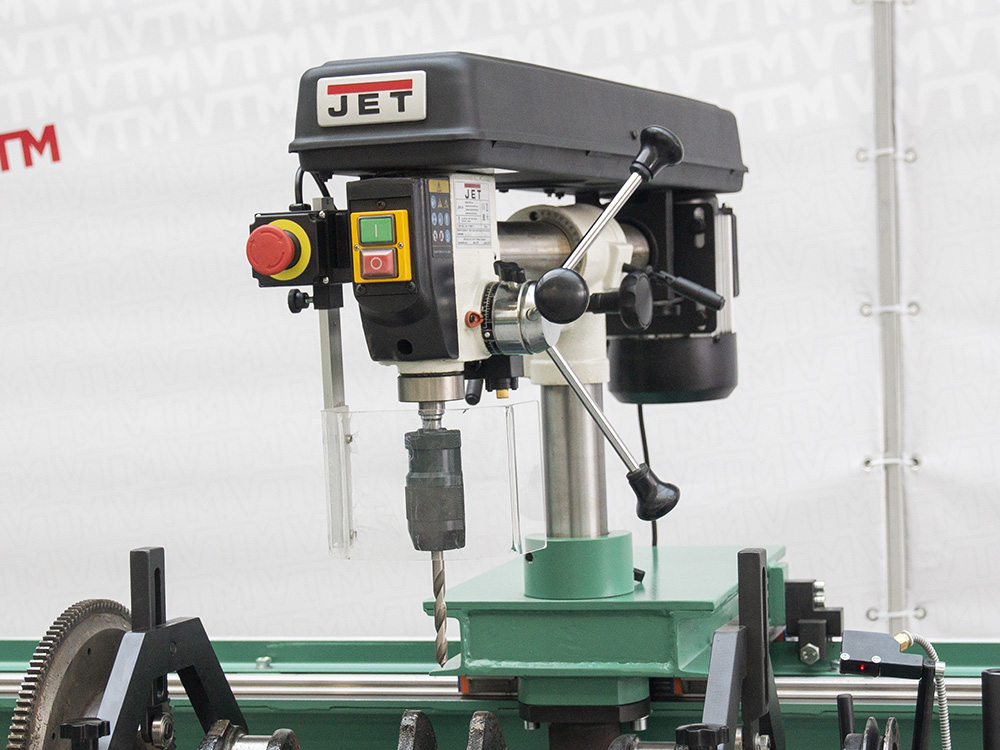
Drilling module
